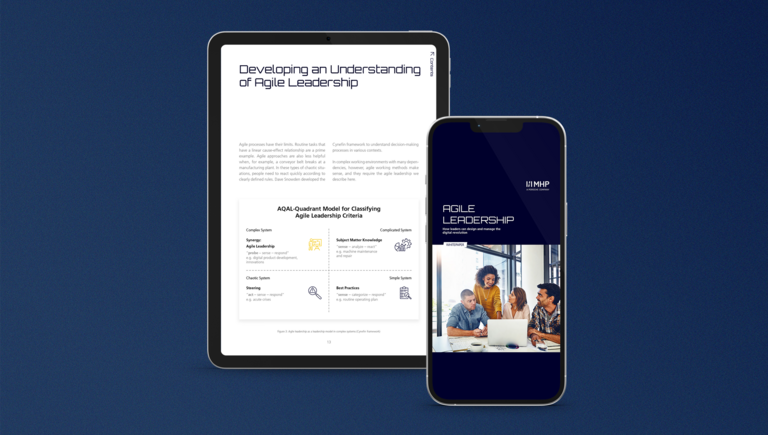
Digital and social transformation require business leaders to change their thinking
Artificial intelligence, the labor shortage, and the search for a sense of purpose—digitalization and a shift in values are causing turmoil in the world of business. Organizations are reacting to the dynamic demands of the market with a wide range of changes. The transformation is particularly challenging for business leaders. Not only are they the driving force behind the procedural and structural changes—they are impacted by them as well. The traditional hierarchical leadership model is increasing under pressure.
In this whitepaper, you’ll learn which circumstances push the traditional management model to its limits—and when an agile leadership approach can help.
It provides helpful guidelines, showing how agile leadership can positively influence teams’ ability to self-organize. But to gain the new leadership skills they need, managers need help from their own ranks. We’ll show you how to develop an appreciation for agile methodologies and mindset among your team members—and which role training sessions, workshops and coaching can play.
Key insights from the Agile Leadership whitepaper:
- In a world of increasing complexity, volatile industry trends and increased customer expectations, tried-and-true leadership approaches are reaching their limits.
- With an agile leadership approach, management responsibility is shared among multiple leaders, which increases employee satisfaction and innovation.
- Agile leaders assume different leadership roles depending on the context. People are the focus of everything they do.
- Agile leaders set parameters within which subject matter experts can make independent decisions.
- Agile leaders encourage a culture of trust and place value on psychological safety within the team.
- With the help of the Four-Quadrant AQAL model, agile readiness and leadership development can be comprehensively assessed.
- As-needed training, workshops, and coaching improve personal leadership skills, encourage agile team roles and processes, and create a future-proof organization.
- Agile leaders understand the relevance of ambidextrous leadership, meaning that there is no either-or decision to make when it comes to agile and traditional leadership.